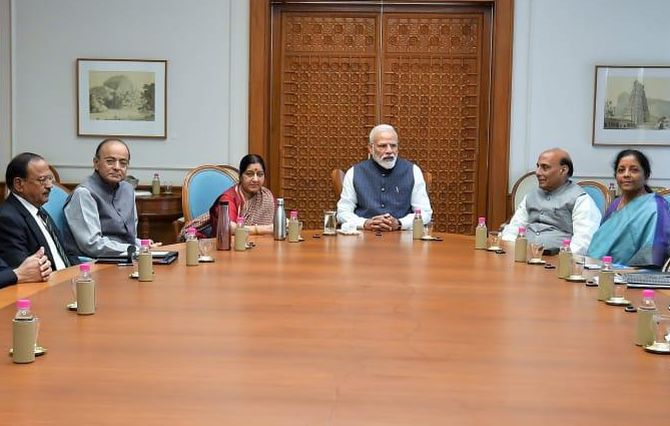This article is written by Oishika Banerji of Amity Law School, Kolkata. This article throws light on cabinet committees, their functions, and their relevance.
Table of Contents
Introduction
Cabinet committees are those extra-constitutional bodies that help in the management of the complex business of the government. These committees draw their roots from the Indian Council Act, 1861 that came into force during the time of Lord Canning, which introduced the portfolio system and the Executive Council of the Governor-General. A change in the name of this office was brought over by the Interim Government of 1946 which designated the Secretariat of the Executive Council as the Cabinet Secretariat, and the Secretary to the Executive Council came to be known as the Cabinet Secretary.
The functions associated with the Cabinet Secretariat went through a transformation to form an organization and were handed the responsibility of carrying out effective coordination between Ministers. Different committees namely Economic Committee, the Directorate of Public Grievances, National Health Authority, Chemical Weapons Convention (NA, CWC), Direct Benefit Transfer (DBT) Mission, Office of Principal Scientific Adviser (O/o PSA) which is also known as the Prime Minister’s Science, Technology and Innovation Advisory Council (PM-STIAC) have been developed by the Cabinet over the years to bring about policies, strategies, innovations in the overall functioning of the government. Currently headed by Cabinet Secretary Shri Rajiv Gauba, the Cabinet Committees have been playing a significant role in handling and managing different circumstances. This article aims to throw some light on the same in the process of highlighting certain important information associated with these committees.
Traits of the Cabinet Committees
The Cabinet Secretariat works directly under the Prime Minister of the nation. But, the administrative head of such a Secretariat is the Secretary of the Cabinet who plays the role of the ex-officio Chairman of the Civil Services Board. The focus should be given to the business that is allocated to the Secretariat under the Government of India (Allocation of Business) Rules, 1961 which includes:
- Secretarial assistance to the Cabinet and Cabinet Committees; and
- Rules of Business.
Drawing from the above discussion, the various features of Cabinet Committees have been laid down hereunder:
- It is the Rules of Business that makes room for the establishment of the Cabinet Committees and therefore, on this ground, the Cabinet Committees are extra-constitutional by nature as no provisions have been incorporated in concern with these committees in the Constitution of India.
- The Cabinet Committees are given shape by the Prime Minister whenever he feels the need for the formation of the same. This also symbolizes that the number of members, composition, and names differ from time to time. Generally, the membership of the Cabinet committees ranges from three to eight.
- The Cabinet committees are generally of two kinds namely standing, and ad hoc. While the former acquires a permanent nature, the latter by its name itself suggests the temporary existence of such committees that are formed in special circumstances and dissolved after fulfillment of their purpose.
- Though the Cabinet committees sound to be open only to the Cabinet ministers for its membership, it expressly or impliedly does not bar non-Cabinet ministers to be a member of the same.
- In place of the Prime Minister, the Home Minister, or the Finance Minister can also be the Chairman of the Committees. A fact to be noted here is that if the Prime Minister is himself a member of one of the committees, he will invariably be heading the same.
- To say that the Cabinet Committees are those devices that work on the basis of the principles of labour division, an effective delegation to reduce Cabinet’s workload, examine policy-related issues, ensure effective coordination among ministers, will constitute both features, and function of these Committees.
List of the Cabinet Committees
Before the Narendra Modi Government came into power in 2014, there were ten Cabinet committees that were in existence namely:
- Cabinet Committee on Economic Affairs;
- Cabinet Committee on Prices;
- Cabinet Committee on Political Affairs;
- Appointments Committee of the Cabinet;
- Cabinet Committee on Security;
- Cabinet Committee on World Trade Organisation (WTO) Matters;
- Cabinet Committee on Investment;
- Cabinet Committee on Unique Identification Authority of India (UIDAI related issues;
- Cabinet Committee on Parliamentary Affairs;
- Cabinet Committee on Accommodation.
Among these ten committees, four were discontinued by the present government in 2016 and incorporated within other committees namely:
- The functions of the Cabinet Committee on Management of Natural Calamities came under Committee under the Cabinet Secretary.
- The working of the Cabinet Committee on Prices came under the Cabinet Committee on Economic Affairs.
- The ambit of the Cabinet Committee on Unique Identification Authority of India came under the scope of the Cabinet Committee on Economic Affairs.
As of 2021, there are eight Cabinet committees functioning namely:
- Appointments Committee of the Cabinet
- Cabinet Committee on Accommodation
- Cabinet Committee on Economic Affairs
- Cabinet Committee on Parliamentary Affairs
- Cabinet Committee on Political Affairs
- Cabinet Committee on Security
- Cabinet Committee on Investment and Growth
- Cabinet Committee on Employment and Skill Development
The four significant Cabinet committees have been listed down below:
- The Political Affairs Committee deals with all policy matters pertaining to domestic and foreign affairs.
- The Economic Affairs Committee directs and coordinates governmental activities in the economic sphere.
- The Appointments Committee decides all higher-level appointments in the Central Secretariat, Public Enterprises, Banks, and Financial Institutions.
- Parliamentary Affairs Committee looks after the progress of government business in the Parliament.
The first three committees in this list are chaired by the Prime Minister whereas it is the Home Minister who looks after the last one. The Political Affairs Committee, familiarly known as “Super-Cabinet” is the most powerful Committee of the Cabinet.

Functions of Cabinet committees
It is the Cabinet Secretariat who is responsible for the functioning of the committees and therefore, the functions allotted to these committees can be understood through the functions of the Cabinet Secretariat as have been presented hereunder:
- The Cabinet Secretariat has been vested with the responsibility of administration of the Government of India (Transaction of Business) Rules, 1961 and Government of India (Allocation of Business) Rules, 1961 thereby facilitating and ensuring smooth transaction of business carried out by different Ministries or Departments by the following ways:
- Circulating papers that are related to the important cases on the agenda.
- Preparing a record of discussions as evidence for future use.
- Circulating record of discussions after the Prime Minister approves the same.
- Monitoring proper implementation of decisions that are taken by the Cabinet and its Committees.
- Convening of the meetings of the Cabinet & its Committees on the orders of the Prime Minister.
- Preparation and circulation of the agenda for discussion.
- Followed by the previous function, the Cabinet Secretariat plays the role of assisting the Government in decision-making thereby ensuring coordination among different Ministries by creasing out differences that arise within various Ministries or Departments.
- The Cabinet Secretariat is involved in ensuring the meeting of minds of different Ministries with the help of the Standing and Ad hoc Committees of Secretaries.
- Cabinet committees collectively work towards managing grave crises that are faced by the nation by means of coordinating different activities of the Ministries in such circumstances. Inter-Ministerial coordination can be ensured in the following ways;
- Removing difficulties.
- Removing differences.
- Overcoming delays.
- Coordination in administrative action.
- Coordination of policies.
- Cabinet committees ensure logical disposal of the Cabinet’s complex workload so as to ensure productive output from the Cabinet.
Formation and abolition of GOMs and EGOMs
GOMs or Group of Ministers which has been formulated for looking into various subjects comes along with the Cabinet committees. They are vested with the power of taking decisions and, or advice to or on behalf of the Cabinet committees. GOMs have behaved as a catalyst for the functions of the Cabinet committees as having been discussed previously. The Group of Ministers are an Ad hoc organization by nature and are constituted for the purpose of delivering recommendations and assisting the Cabinet and its ministers in critical areas of decision-making. After the purpose is fulfilled, the GOMs formed are dissolved.
Empowered Group of Ministers (EGoM) is a type of Group of Ministers (GoM) belonging to the Central Government who are appointed by the Cabinet, a Cabinet Committee or the Prime Minister for the purpose of conducting investigation and reporting on the same to the Cabinet. These Group of Ministers are also authorized by its appointing authority to take adequate decisions in matters that follow the investigation conducted.
It is to be noted that while the GOMs are not vested with the power of decision-making on the matters investigated thereby being subject to the decisions of the Cabinet, the EGOMs can take decisions following investigation and reporting the same to the Cabinet. Thus lies the difference in their names. Both these Group of Ministers are appointed on the basis of para 6(4) of the Government of India’s (Transaction of Business) Rules 1961 which lays down the establishment of such groups by the Cabinet. It is required to know that the decisions of the Standing or Ad hoc Committee are subjected to review by the Cabinet. This technically becomes extra work for the Cabinet thereby defeating the whole purpose for the formulation of the committees or groups to reduce its workload. Taking this into account, the Narendra Modi Government on 31st May 2014 decided to scrap down all the existing Empowered Group of Ministers (EGoMs) which were nine in number and twenty-one Groups of Ministers (GoMs) with an aim of speeding the process of decision-making by the Cabinet and ensuring accountability in the entire system.
Conclusion
Cabinet committees have played relevant roles in guiding the Cabinet and its ministers in the process of handling the largest democracy of the world. In order to ensure transparency among these committees, it is the government that must take due responsibility for the ineffective working of the executive wing of the government.
References
- https://cabsec.gov.in/councilofministers/cabinetcommittees/
- https://pib.gov.in/Pressreleaseshare.aspx?PRID=1573622
- https://pm.gc.ca/en/cabinet-committee-mandate-and-membership
- https://scroll.in/latest/1000058/centre-reconstitutes-cabinet-committees-anurag-thakur-part-of-parliamentary-affairs-panel
LawSikho has created a telegram group for exchanging legal knowledge, referrals and various opportunities. You can click on this link and join:
https://t.me/joinchat/J_0YrBa4IBSHdpuTfQO_sA
Follow us on Instagram and subscribe to our YouTube channel for more amazing legal content.












